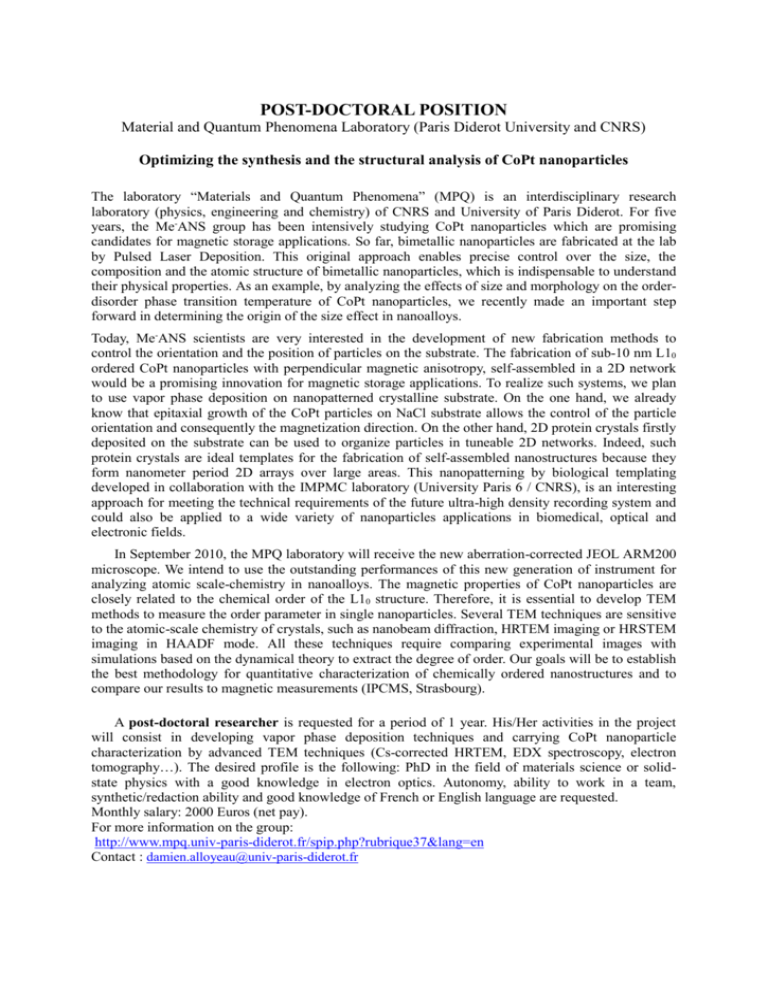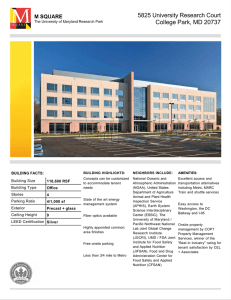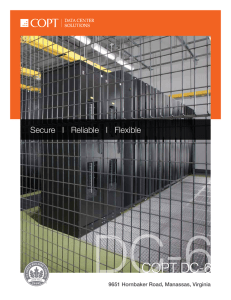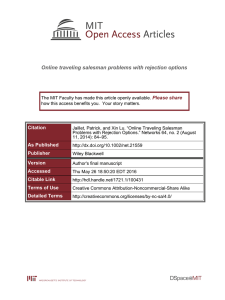POST-DOCTORAL POSITION
advertisement

POST-DOCTORAL POSITION Material and Quantum Phenomena Laboratory (Paris Diderot University and CNRS) Optimizing the synthesis and the structural analysis of CoPt nanoparticles The laboratory “Materials and Quantum Phenomena” (MPQ) is an interdisciplinary research laboratory (physics, engineering and chemistry) of CNRS and University of Paris Diderot. For five years, the Me-ANS group has been intensively studying CoPt nanoparticles which are promising candidates for magnetic storage applications. So far, bimetallic nanoparticles are fabricated at the lab by Pulsed Laser Deposition. This original approach enables precise control over the size, the composition and the atomic structure of bimetallic nanoparticles, which is indispensable to understand their physical properties. As an example, by analyzing the effects of size and morphology on the orderdisorder phase transition temperature of CoPt nanoparticles, we recently made an important step forward in determining the origin of the size effect in nanoalloys. Today, Me-ANS scientists are very interested in the development of new fabrication methods to control the orientation and the position of particles on the substrate. The fabrication of sub-10 nm L10 ordered CoPt nanoparticles with perpendicular magnetic anisotropy, self-assembled in a 2D network would be a promising innovation for magnetic storage applications. To realize such systems, we plan to use vapor phase deposition on nanopatterned crystalline substrate. On the one hand, we already know that epitaxial growth of the CoPt particles on NaCl substrate allows the control of the particle orientation and consequently the magnetization direction. On the other hand, 2D protein crystals firstly deposited on the substrate can be used to organize particles in tuneable 2D networks. Indeed, such protein crystals are ideal templates for the fabrication of self-assembled nanostructures because they form nanometer period 2D arrays over large areas. This nanopatterning by biological templating developed in collaboration with the IMPMC laboratory (University Paris 6 / CNRS), is an interesting approach for meeting the technical requirements of the future ultra-high density recording system and could also be applied to a wide variety of nanoparticles applications in biomedical, optical and electronic fields. In September 2010, the MPQ laboratory will receive the new aberration-corrected JEOL ARM200 microscope. We intend to use the outstanding performances of this new generation of instrument for analyzing atomic scale-chemistry in nanoalloys. The magnetic properties of CoPt nanoparticles are closely related to the chemical order of the L10 structure. Therefore, it is essential to develop TEM methods to measure the order parameter in single nanoparticles. Several TEM techniques are sensitive to the atomic-scale chemistry of crystals, such as nanobeam diffraction, HRTEM imaging or HRSTEM imaging in HAADF mode. All these techniques require comparing experimental images with simulations based on the dynamical theory to extract the degree of order. Our goals will be to establish the best methodology for quantitative characterization of chemically ordered nanostructures and to compare our results to magnetic measurements (IPCMS, Strasbourg). A post-doctoral researcher is requested for a period of 1 year. His/Her activities in the project will consist in developing vapor phase deposition techniques and carrying CoPt nanoparticle characterization by advanced TEM techniques (Cs-corrected HRTEM, EDX spectroscopy, electron tomography…). The desired profile is the following: PhD in the field of materials science or solidstate physics with a good knowledge in electron optics. Autonomy, ability to work in a team, synthetic/redaction ability and good knowledge of French or English language are requested. Monthly salary: 2000 Euros (net pay). For more information on the group: http://www.mpq.univ-paris-diderot.fr/spip.php?rubrique37&lang=en Contact : damien.alloyeau@univ-paris-diderot.fr











